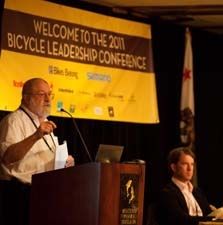MONTEREY, CA (BRAIN)—A world population about to reach 7 billion people opens up new opportunities for business in global markets, according to Jay Townley of the Gluskin Townley Group.
Speaking to a packed conference room during the Bicycle Leadership Conference yesterday, Townley cited China and India as newly attractive target markets.
Townley said these emerging markets have a broad middle-income group that scarcely existed 50 years ago. On the whole, the world’s 7 billion residents are now 82 percent literate and 51 percent live in urban environments, opening up a larger global customer base.
Due to population distribution, buying power is concentrated in cities on a global basis. Today, 600 urban centers around the world control 60 percent of global purchasing. “In 14 years it won’t be the same cities. But in global business you have to watch those city centers,” said Townley.
Townley said among the developed markets, the United States is the only one that in the next 14 years is expected to return to growth. “America will be back. Why? Because we have a new baby boom,” said Townley.
Regional differences will play out in the U.S. market as America is no longer one bike market but nine distinct regional markets. And as the U.S. population has shifted south and west, suppliers should put more emphasis on growing markets such as Atlanta, said Townley.
Jim Kelley, managing director for Leisure Trends Group, speaking on the same panel, said suppliers should also emphasize grassroots marketing and building brand awareness with the consumer.
Based on a consumer insights study of 2,165 active Americans last month, Leisure Trends Group found that of consumers who purchased a road bike last year, 52 percent had a brand in mind before they made a purchase. Of that group who had a brand in mind, 80 percent actually purchased that brand.
“What’s surprising and important for this group is the conversion,” said Kelley. “There is a clear wakeup call to get inside the heads of consumers and develop that brand preference before they walk in that store.”
Among consumers surveyed, the largest chunk (45 percent) purchased their road bike at an independent bike dealer. That was followed by 18 percent at a specialty bike chain such as Performance, and 11 percent from an online retailer such as eBay.
Kelley said while IBD purchases peaked with 45-54 year olds and online purchases were strongest among younger age groups, there were no real variations in purchasing behavior based on income level or riding frequency.
The most surprising survey finding was the level of used bike purchases. Most recent road bike purchases were new (78 percent) but 22 percent of bike purchases were used. Kelley said in the decision tree, new versus used bikes rose to the top of the process; the only other major buying decision was what type of bike to purchase.
“Every way we cut the data, the used bike market is important—that’s one of the key nuggets from study,” said Kelley.
—Megan Tompkins
mtompkins@bicycleretailer.com
Photo credit: Brightroom


